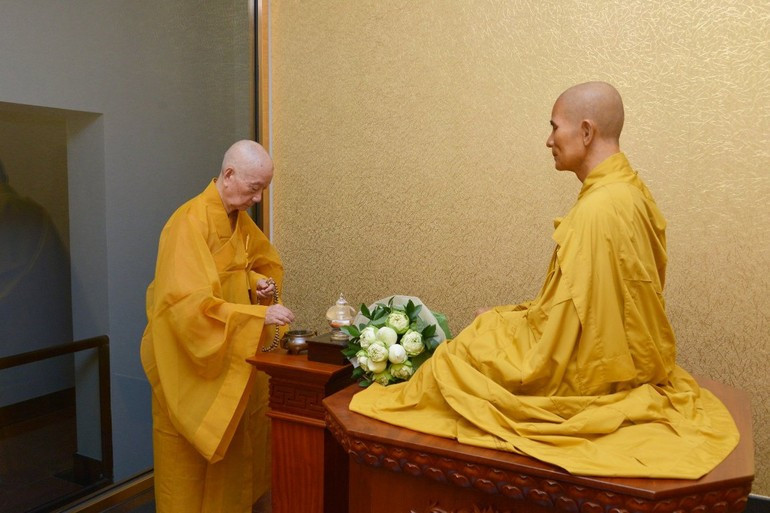
A major highlight of the 2025 UN Day of Vesak celebration in Ho Chi Minh City is the enshrinement of sacred Buddhist relics brought from India to Thanh Tam Pagoda (Binh Chanh District) and the enshrinement of the immortal heart relic of Bodhisattva Thich Quang Duc at Vietnam Quoc Tu Pagoda (District 10, Ho Chi Minh City).
Bodhisattva Thich Quang Duc self-immolated on June 11, 1963 (the 20th day of the leap April in the lunar calendar, Year of the Cat), in protest against the oppressive policies of the Ngo Dinh Diem regime.
"The sacred flame and immortal heart are miraculous evidence of great compassion, meditative power, and spiritual attainment that transcend all worldly limits," affirmed a resolution of the Standing Committee of the Supreme Patriarchal Council on April 4, 2025.
A legacy of pride
The Fourth Supreme Patriarch of the Vietnamese Buddhist Sangha, Most Venerable Thich Tri Quang, declared: "We are proud of a heroic chapter in our nation’s history, marked by the noble vow of Bodhisattva Thich Quang Duc, who served both the Dharma and the Nation."
According to him, the compassionate fire and the indestructible heart of Thich Quang Duc possess the power to illuminate and awaken human conscience, dissolving all hatred.
"That sacred flame teaches us to rise above selfish individualism and extremist ideologies. He is a shining embodiment of the compassionate, wise, and courageous spirit of a living bodhisattva and of Vietnamese Buddhism’s socially engaged path," the Most Venerable said.
The late Venerable Thich Tri Quang, a spiritual leader in the 1963 Buddhist nonviolent resistance movement against the Ngo Dinh Diem regime, once remarked: "One of the eternal aspects of the 1963 movement was the emergence of a bodhisattva. Thich Quang Duc’s self-immolation immediately shook Diem. Within hours, his image was broadcast across the world, especially in the U.S., as the flames of his act engulfed and destroyed Diem’s public image and regime."
He added that the fire of Quang Duc ignited a level of moral intensity that Diem could no longer withstand or suppress.
In his recollection, the Most Venerable Thich Duc Nghiep, Deputy Supreme Patriarch and Chief of Monastic Discipline, vividly remembered the scene: "The flames soared skyward! The shock among the monastics and onlookers was indescribable. There were tears, cries! I immediately ordered twenty monks and nuns to lie across all four road entrances to prevent fire trucks from reaching the site. Among the eyewitnesses were Simon Michaud from AFP (France), Malcolm Browne from AP (USA), and Neil Sheehan from UPI, along with the vehicle of U.S. General Hawkins."
According to Most Venerable Thich Duc Nghiep, after about 30 minutes, the charred body of the Venerable was carried on a Buddhist flag back to Xa Loi Pagoda. At the gate, lay devotee Mai Tho Truyen laid himself on the ground beneath the body, from the gate to the Dharma hall. Waves of people poured into the pagoda to pay homage to the bodhisattva. The self-immolation was reported on radio stations across Vietnam and around the world.
"This news stirred the hearts of people across the five continents, shaking the foundations of a discriminatory and authoritarian regime. As a result, Diem was pressured into convening the Joint Governmental-Religious Committees, which later issued a joint communiqué," Most Venerable Thich Duc Nghiep recounted.
A global shockwave
According to Professor Le Manh That, Bodhisattva Thich Quang Duc’s self-immolation is a timeless spiritual symbol that should be studied from scientific, historical, and religious perspectives to educate future generations on its profound meaning. His act became a rallying force uniting people for the Dharma and the nation.
In his book The Torch of Quang Duc, the Most Venerable Thich Duc Nhuan wrote: "The fire of Quang Duc illuminated an era darkened by war and hatred, amid the human condition weighed down by anxiety, distrust, and despair."
"The thousand-degree flames failed to destroy the indestructible diamond heart of a bodhisattva who burned himself for the Dharma," Most Venerable Thich Duc Nhuan affirmed.
Bodhisattva Thich Quang Duc is a historical figure who made immense contributions to both Buddhism and the Vietnamese nation, bringing honor to both. His self-immolation was a monumental event that shook the world and awakened the conscience of humanity.
He was a Vietnamese Buddhist who, faced with the threat to his faith and a nation in turmoil, made a profoundly sorrowful yet heroic decision: to immolate himself in protest of the violent repression by Ngo Dinh Diem's authoritarian regime. His act called for religious freedom, national unity, and global peace.
The self-immolation of Bodhisattva Thich Quang Duc lit a fire in the hearts of millions, awakening the moral conscience of the world and entering the annals of history: "For a thousand years, the heart of the Bodhisattva will live on."
Luu Dinh Long